Advertising is an effective way to monetize your website. But it isn’t about plastering your site with random ads from any source. You need a reliable ad network that delivers high-paying ads for your niche. Luckily, you shouldn’t stress about finding such a network for your site. We’ve compiled a list of the best ad networks for publishers in 2025.
Note that this article is frequently updated to ensure publishers learn about new changes from the ad networks and always get current information to guide them towards making the best decision. If you notice anything is missing from this list, please don’t hesitate to contact us. We appreciate your feedback and will gladly update the article according to relevant recommendations.
What is an ad network?
An ad network is a platform that connects app or website publishers to brands that want to advertise their products and services. The network’s primary function is to aggregate advertising slots and match them with the advertiser’s demand. Publishers monetize their websites easily with ads instead of doing one-on-one direct sales pitches to potential advertisers, which takes considerable time and effort. Best ad networks streamline the ad exchange and traffic processes the most effective way.
How ad networks work: a publisher’s perspective
Ad networks (ad servers) work as a trustworthy middleman between publishers and advertisers, orchestrating selling ad space and ad revenue receipt for publishers.
Every Publisher has its own partner’s account that provides necessary ad inventory, tools, stats, and more to start earning at once.
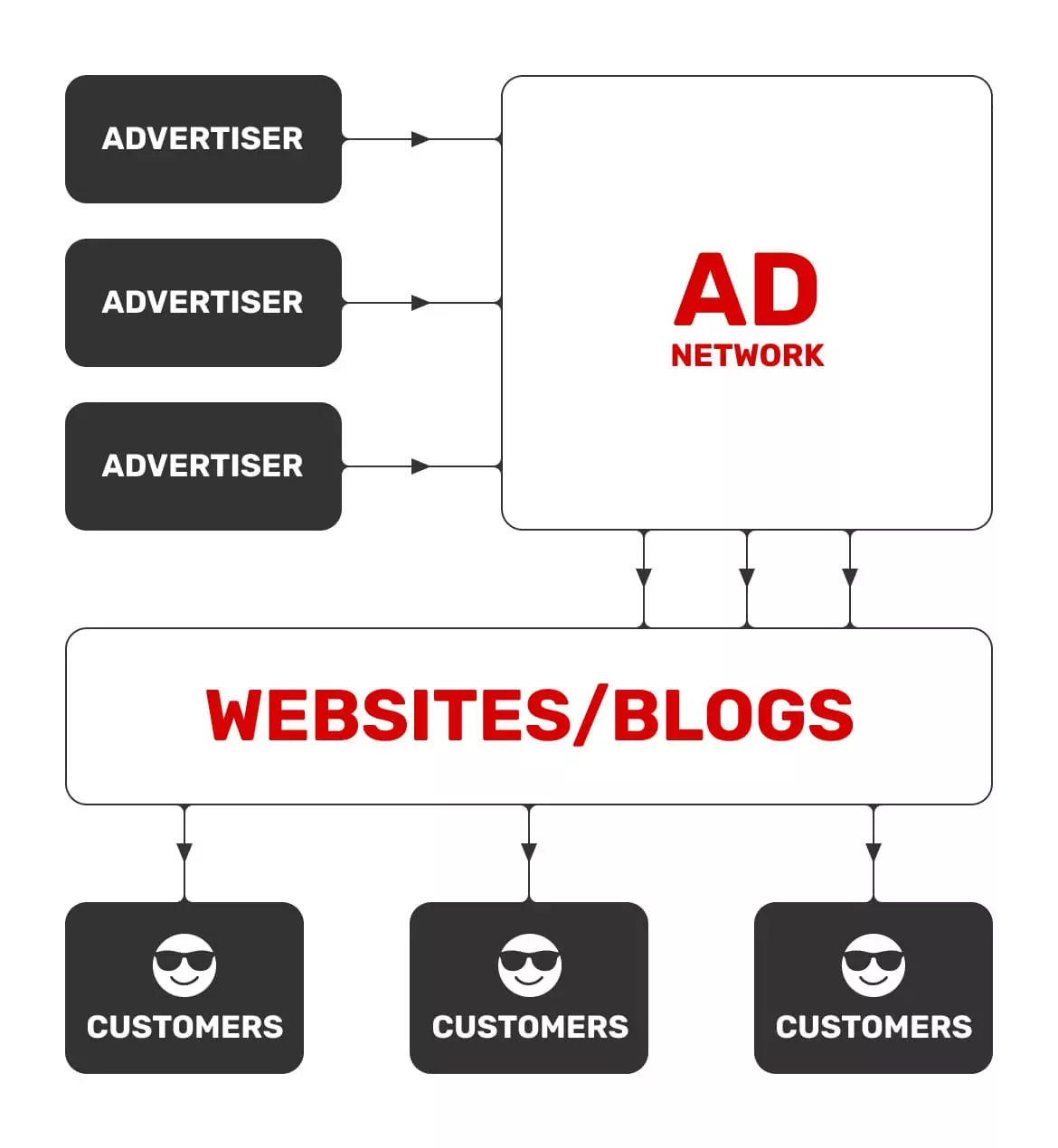
As a Publisher, you need to register with the network, wait a little for website approval, copy and paste a preferable ad code on to your site or blog page.
Alternatively, if you have a social media blog, you do not need to have a website. Register with an ad network and copy Smartlink and place it anywhere suitable. Smartlink is a simple url that shows ads to your audience, while you earn income.
As ad networks deal with advertisers directly, and publishers only need to sign up and get their sites approved. Once that occurs, they can tap into the network’s ad inventory and start earning money, saving considerable time and effort.
Benefits of ad networks for publishers
The main benefits of working with ad networks meant for publishers is that such partnership eliminates stress and complexity. Without these networks, a publisher would need to constantly pitch brands for ads, which is cumbersome. Small publishers would have little chance because they lack the knowledge and experience in dealing with advertisers.
Let’s look into more benefits available for publishers in the table below, with Adsterra among examples of top advertising networks.
Table 1. Ad Networks for Earning: Publishers’ Benefits per Adsterra
| Benefits to looks for | |
| Registration | Under 10-minute moderation |
| Payments | Variety of options |
| Payment Frequency | Every 2 weeks |
| Minimum payout | $5 (e.g., for Paxum) |
| Ad inventory | Popunder, Social Bar (or In-Page Push ads), Native Ads, Display Banners, Smartlink ads, Interstitials, and more. |
| Support | Partner Care Program, 24/7 support |
| More ways to earn | 5% referrals |
| Anti-malware | In-house, third-party security |
| Anti Ad Blocker feature | Ad revenue increase of up to 35% |
| Location | 248 geos |
| CPM (click-per-thousand-impression) | High, plus 100% fill rate |
| Publisher’s account | Intuitive interface, all you need technology-wise |
Choosing the network to earn? Go through quick approval and see all your options for monetization and immediately start. 220K+ new ad campaigns added to the ongoing ones (per year) and up to 30% CTR on Social Bar ads.
Types of ad networks
Advertising networks are differentiated by niche, size, inventory volume, and ad delivery method. Some common types of ad networks include:
1. Premium ad networks
A premium ad network focuses on delivering exclusive, high-paying ads. These networks work with a select group of publishers and often have strict registration requirements. Some demand a minimum traffic volume or work only in a specific niche.
Because of their exclusivity, premium ad networks pay the best to websites owners. You can earn lucrative amounts by delivering premium ads to your audience, relevant ads to which they’ll likely respond.
2. Vertical ad networks
A vertical ad network focuses on a single niche or industry. Its purpose is to help businesses in that industry advertise to their perfect target audience. By providing this audience to interested advertisers, you can earn hefty sums.
The volume of ads might be lower on a vertical ad network, but they still convert well because of their precise targeting.
3. Horizontal ad networks
Horizontal ad networks have a broad reach, the opposite of vertical networks. They serve many niches and connect publishers to a wide range of advertisers. Here, advertising is not as precisely targeted as with vertical networks, but volume is high, allowing you to fill your ad slots 100%.
4. Affiliate ad network
Affiliate marketing involves publishers promoting products in exchange for commissions. The publisher advertises the product to their audience and collects a commission for each sale or other conversion. Affiliate ad networks give media publishers access to high-paying affiliate offers. They provide reporting tools and training to help affiliates or publishers produce better results and earn more money.
Additionally, we can single out:
- Business ad networks,
- Mobile ad networks,
- Video ad networks,
- Technology ad networks,
- Automotive ad networks,
- Remnant ad networks,
- Fashion ad networks, and other various ad networks that pay for impressions and allow publishers and advertisers to work together.
Top 14 Ad Networks for Publishers in 2025
You can choose from thousands of different ad networks, but not all are worth their weight in gold. Below, we’ll explore the best advertising networks for websites’ owners or publishers with a blog across different niches.
1. Adsterra
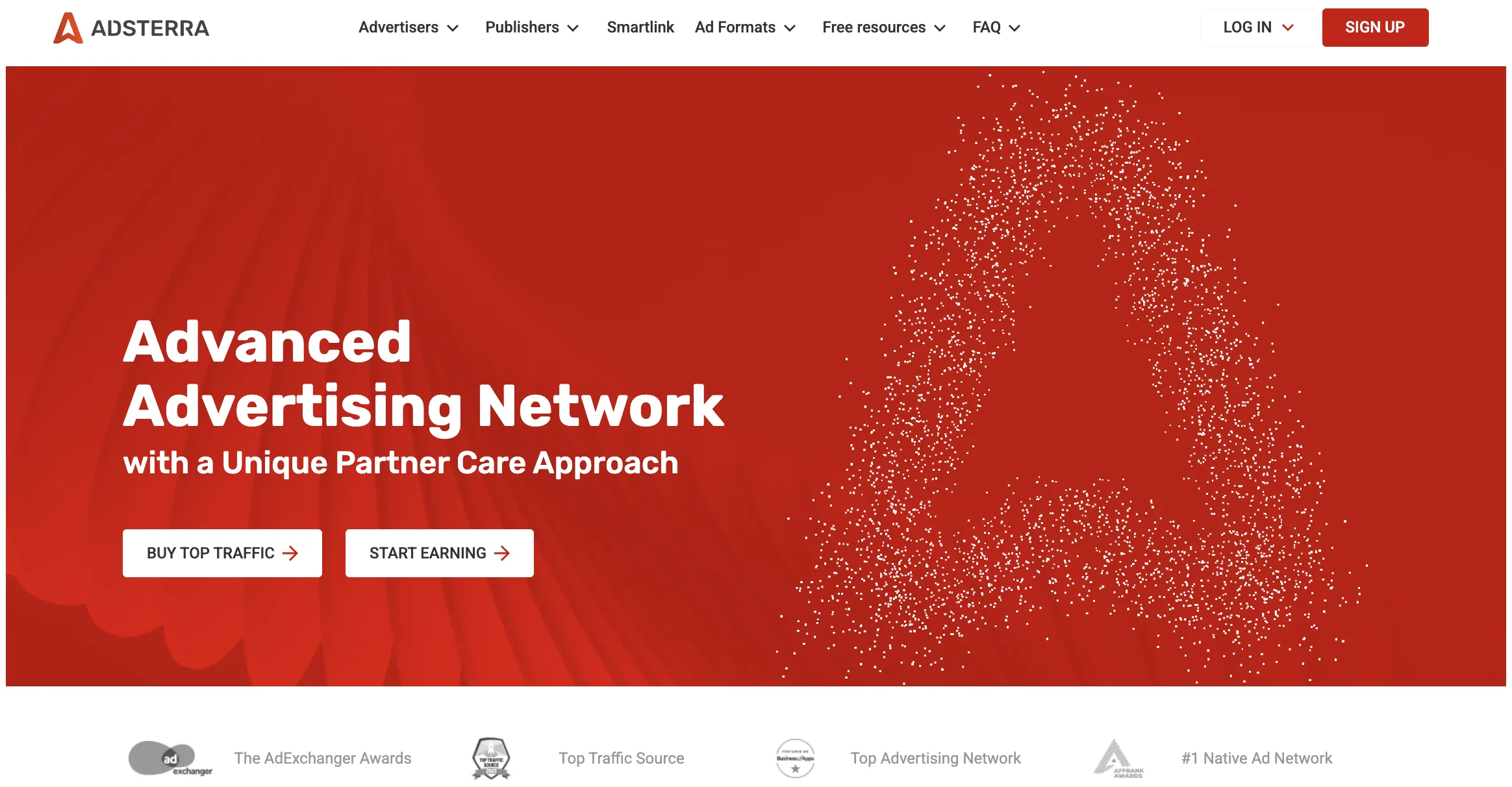
Adsterra is a preferred ad network for years, among 36,000 publishers and 15,000 advertisers. Publishers’ websites’ approval is usually very quick. The platform boasts a 100% fill rate, which guarantees revenues for publishers with any traffic. It supports various types of ad formats, including the industry-advanced, innovative Social Bar with 30% higher CTRs, Popunders, Native Ads, Banner ads, and of course, Adsterra is also one of the best push notification ad networks for websites or blogs and ad network that pays per impression.
The platform has high rates, which are favorable to publishers. You can check out a case study of a blogger who made $1,200 from about 230,000 web visits in roughly two months.
Models: Cost-per-mille (CPM), cost-per-action (CPA).
Minimum traffic: None.
Payout methods: PayPal, wire transfer, Paxum, local bank transfers, and more ways. The minimum payout is $5.
Advantages of Adsterra for publishers
- This ad network guarantees a 100% fill rate. Thus, you can be sure that there will be ads wherever you insert the ad code and earn a steady income.
- There’s no minimum amount of traffic required to sign up on Adsterra. Starting off, many publishers monetize website ad placements with little traffic and increase monthly ad revenue potential as they grow. Many networks have minimum traffic requirements that are unfavorable to smaller publishers. That is why Adsterra is also the best ad networks for small publishers.
- Adsterra is also one of the best native ads network, offering a variety of templates and ad formats you can test for the best conversion.
- Adsterra lets you display ads on your site even when website visitors have installed ad-blocking software. This gives you revenue that you would otherwise have lost due to the growing adoption of ad-blocking tools.
- This ad network supports many payout methods. Publishers can receive their income through Paxum, PayPal, wire transfer, local bank transfers, and other ways. There’s no need to stress because all you need is a bank account or an account on one of the aforementioned payment platforms.
- Adsterra has an excellent support team within the unique Partner Care Program designed for every Partner. Publishers can get in touch with an account manager that’ll help them maximize ad revenue potential.
Publishers who monetize with Adsterra highlight its super-friendly platform. You get your website approved in minutes, so nothing stops you from placing ad codes today.
2. Google AdSense
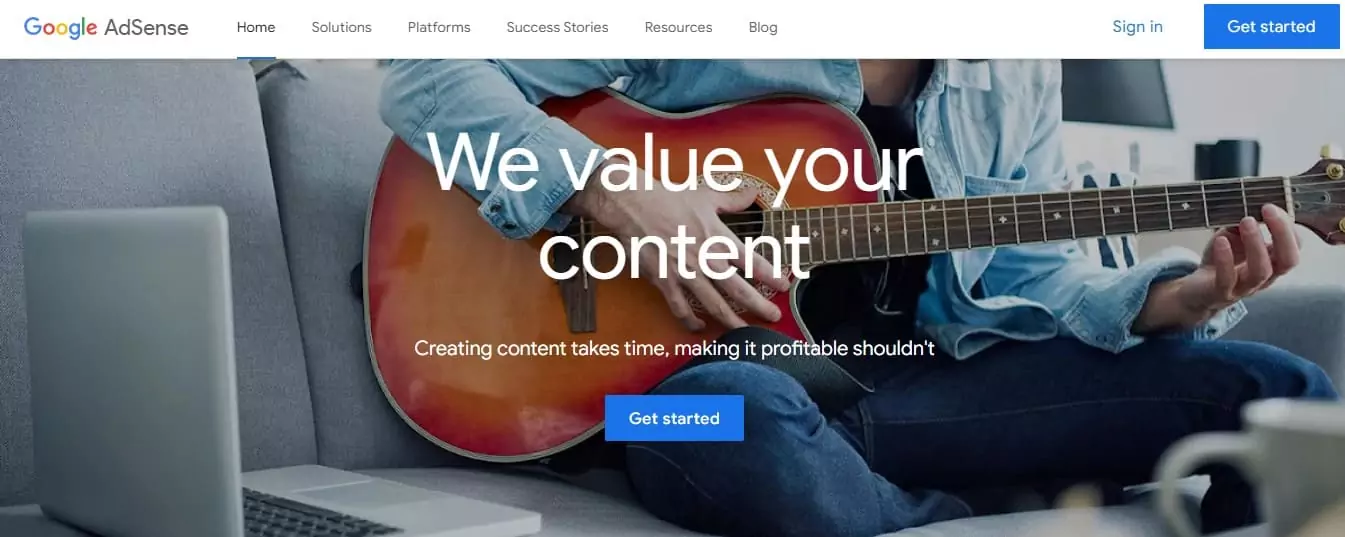
Pros
- An extensive ad inventory
- Clean and user-friendly interface
- Supports many ad formats
- Google Certified Publishing Partner (GCPP) option
Cons
- Strict restrictions on website content
- High minimum payout ($100)
Google AdSense is the largest ad network, with hundreds of thousands of publishers and advertisers signed up.
This network is the best for generic publishers but doesn’t serve niche ones very well (here, you can check out the Google revenue alternatives). It offers lower payouts for niche sites than you can get on the alternatives and takes a long time to earn considerable income.
The good thing going for AdSense is that it’s very easy to use. The platform supports a large variety of ads. It is widely recognized as one of the best ad networks for bloggers and publishers.
Models: CPC, CPM, and CPE (cost-per-engagement).
Minimum traffic: There’s no minimum traffic listed in their requirements, although they may reject websites with little or no traffic.
Payout methods: Wire transfer, check, and electronic funds transfer.
3. PropellerAds
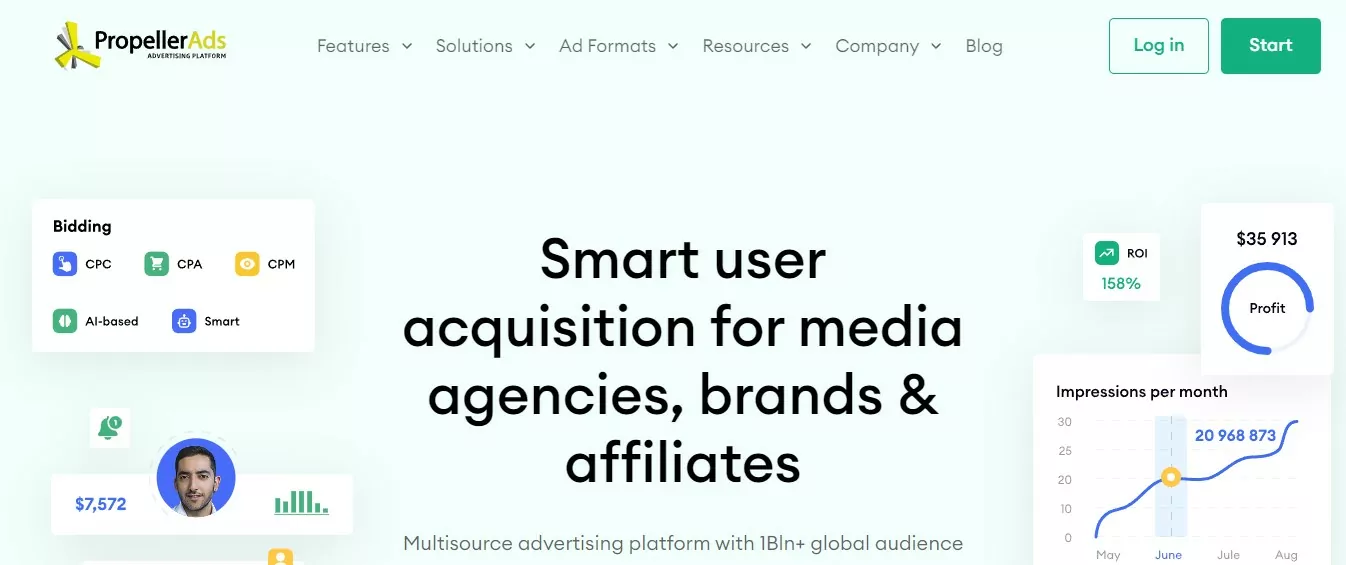
Pros
- Low payment threshold
- Easy to gain approval
- Detailed analytics and reporting
Cons
- No real-time bidding
PropellerAds is a well-known display and mobile advertising network that claims over 100,000 customers. Advertisers can target over 195 geographical locations (GEOs) with quality ensured by sophisticated anti-ad fraud software. Publishers can sign up easily and start earning revenue once approved. Supported ad units include popunders, interstitial ads, and push notifications.
This ad network boasts of delivering over 12 billion ad impressions daily. Advertisers can run and manage ad campaigns in different formats or even combine multiple formats for a single ad campaign. The multi-format advertising is a boon for publishers because it increases the number of ads they can display.
Models: CPM, CPC, CPA.
Minimum traffic: None.
Payout methods: PayPal, WebMoney, wire transfer, Skrill, ePayments, and Payoneer.d Payoneer.
4. Amazon Publisher Services
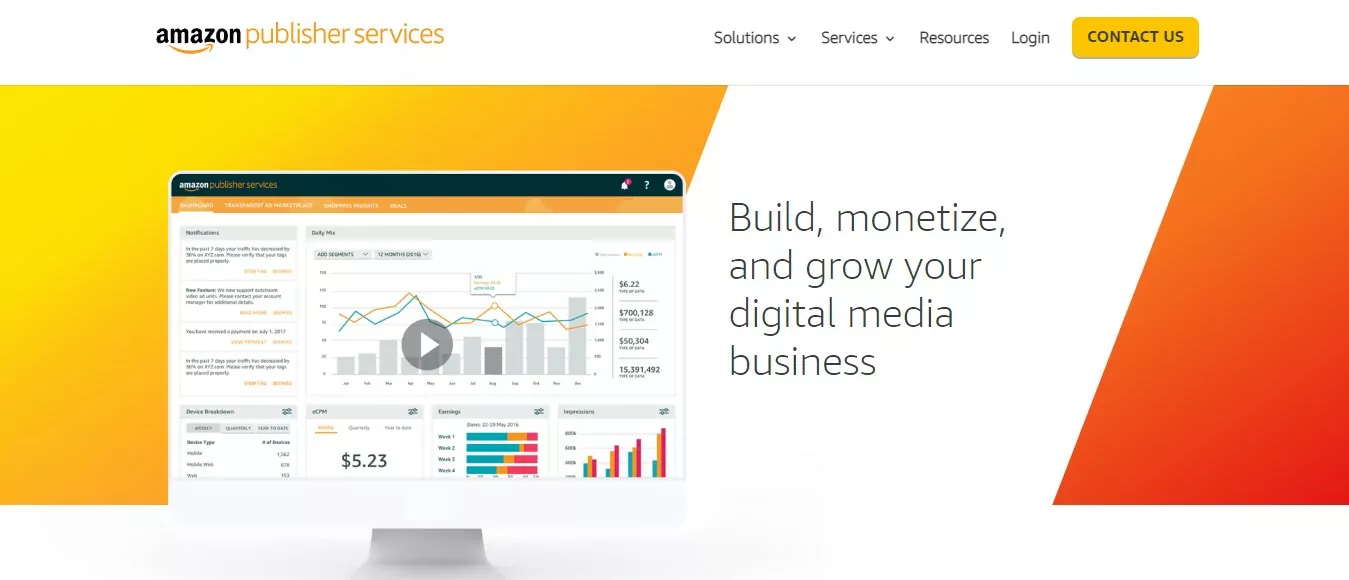
Pros
- High-paying offers
- User-friendly interface
Cons
- Stringent vetting process
Amazon is best known as an online store, but its business encompasses many other areas, including online advertising. Amazon Publisher Services is a unified ad marketplace that connects websites with advertisers and charges zero fees.
This ad network gives publishers unlimited access to ad buyers, mostly brands selling on Amazon. It has a simple interface that makes it easy to keep track of your ads and earnings. There’s no minimum traffic required to monetize your website with this network, which is good.
The main drawback is that Amazon has a tough vetting process to accept websites into its network, which discourages most publishers from applying. Yet, you can always give it a shot.
Models: CPC and CPA.
Minimum traffic: None.
Payout methods: Wire transfer, check, and electronic funds transfer.
5. RevenueHits
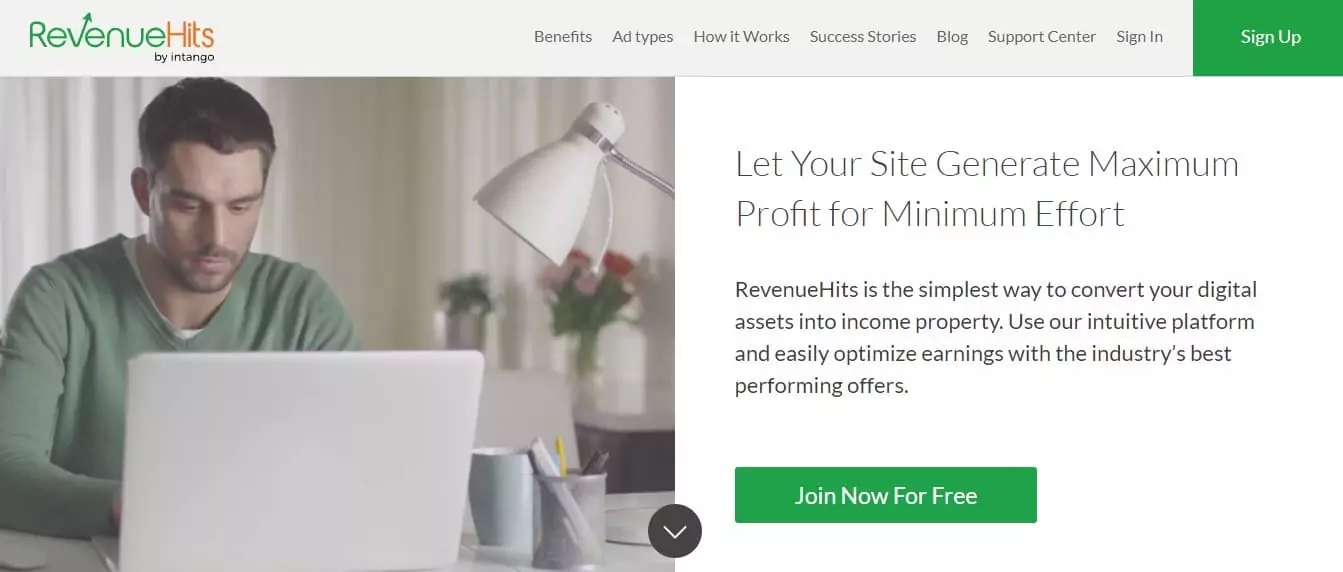
Pros
- It supports many advertising formats
- Broad ad niches
- Easy to sign up and use
Cons
- Limited reporting capabilities
Intango (formerly RevenueHits) is a well-known ad network with over 5,000 advertisers and 20,000 publishers registered on it. The company claims a 100% fill rate and supports many ad formats, including sticky ads, in-page push, popunders, display banners, etc.
Signing up on this network is noticeably easy. Once you join, you can start earning revenue from your website’s ad space regardless of your level of traffic. This ad network has competitive rates for publishers. It also offers regular payouts so that publishers can have a good cash flow.
Models: CPM, CPC, CPA, CPI, and CPL.
Minimum traffic: None.
Payout methods: Wire transfer, PayPal, and Payoneer.
6. TrafficStars
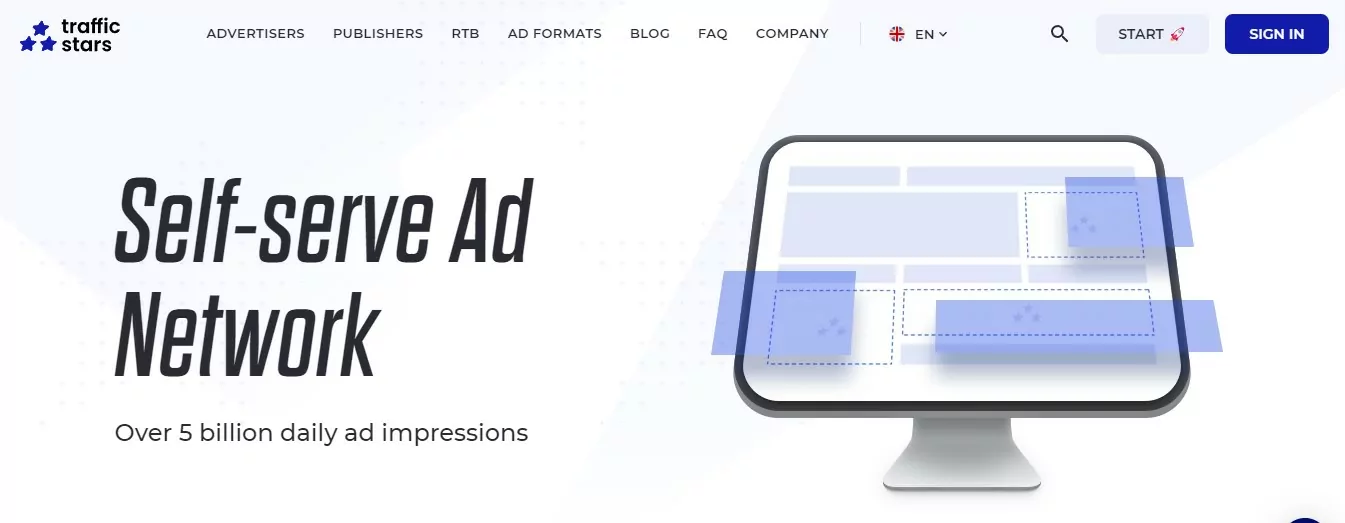
Pros
- High-paying ads
- Supports plenty of formats
- No minimum traffic requirements
Cons
- Limited advertising niches
TrafficStars is a self-serve ad platform that supports various ad formats, including sliders, interstitials, video ad pre-roll, banner ads, and push. One of the unique things about this platform is that it supports real-time bidding (RTB), wherein advertisers can bid for publishers’ ad slots in real time. RTB enables advertisers to maximize outcomes and publishers to get more value from their ad space with competitive bidding.
Models: CPM, CPA, and CPC.
Minimum traffic: None.
Payout methods: Bank transfer, digital currency, ePayService, Paxum, and others.
7. Publift
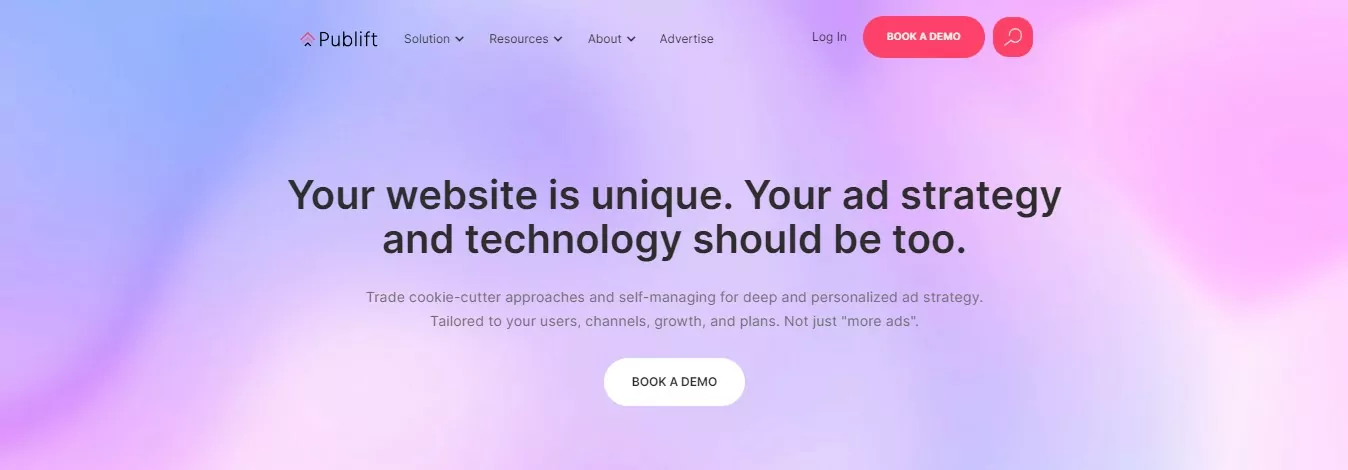
Pros
- High fill rates
- First-rate customer service
- Extensive integrations with other ad networks
Cons
- Very selective criteria for publishers
Publift is one of the top ad networks for publishers because it enables them to personalize their ad strategy to earn as much as they can. It works for both websites and apps and supports ad formats like sticky ads, banner ads, vignettes, and multiplex.
Publift delivers its own ads and ads from ad network partners like AdSense, Xandr, and Amazon Publisher Services.
Models: CPM, CPC, CPA, CPI, and CPL.
Minimum traffic: 500,000 monthly page views, or already earning at least $2,000 per month.
Payout methods: Bank transfer.
Unlike many ad networks, there’s no minimum traffic for publishers to sign up on Adsterra. You can join when you’re small and grow your revenue alongside your site with us.
8. Adcash
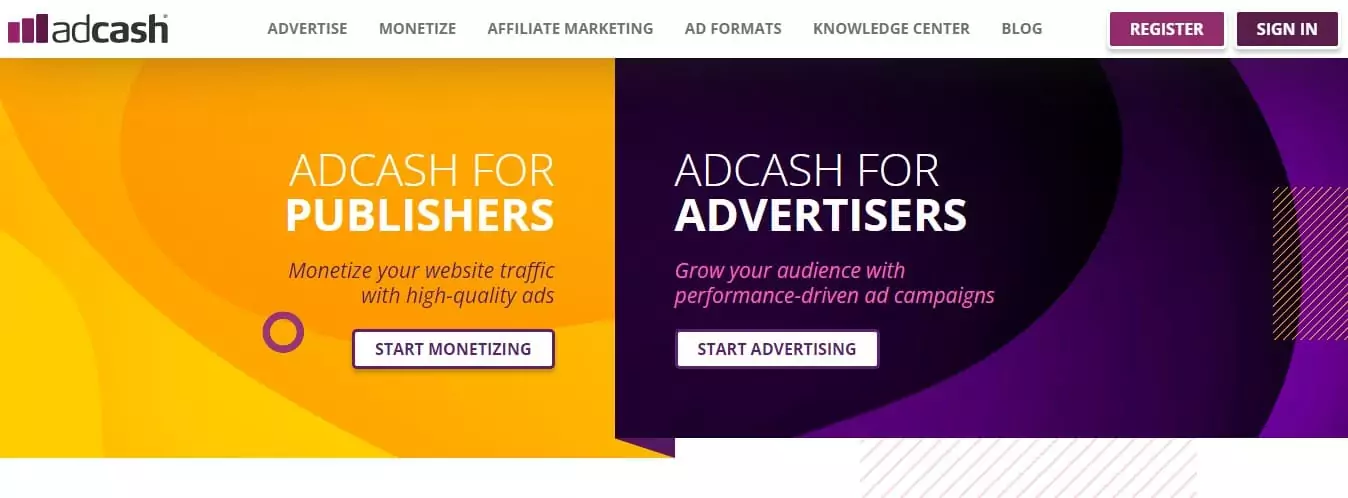
Pros
- Access to relevant, targeted ads
- User-friendly platform
Cons
- Lower CPM rates than competitors
Adcash is an Estonian online advertising platform. It serves publishers around the world, supporting many ad formats, including popunders, banners, interstitials, and autotag. The platform offers dedicated account managers to help publishers maximize revenue.
Models: CPM, CPC, and CPA.
Minimum traffic: None.
Payout methods: Wire transfer, PayPal, and digital currency.
9. Clickadu
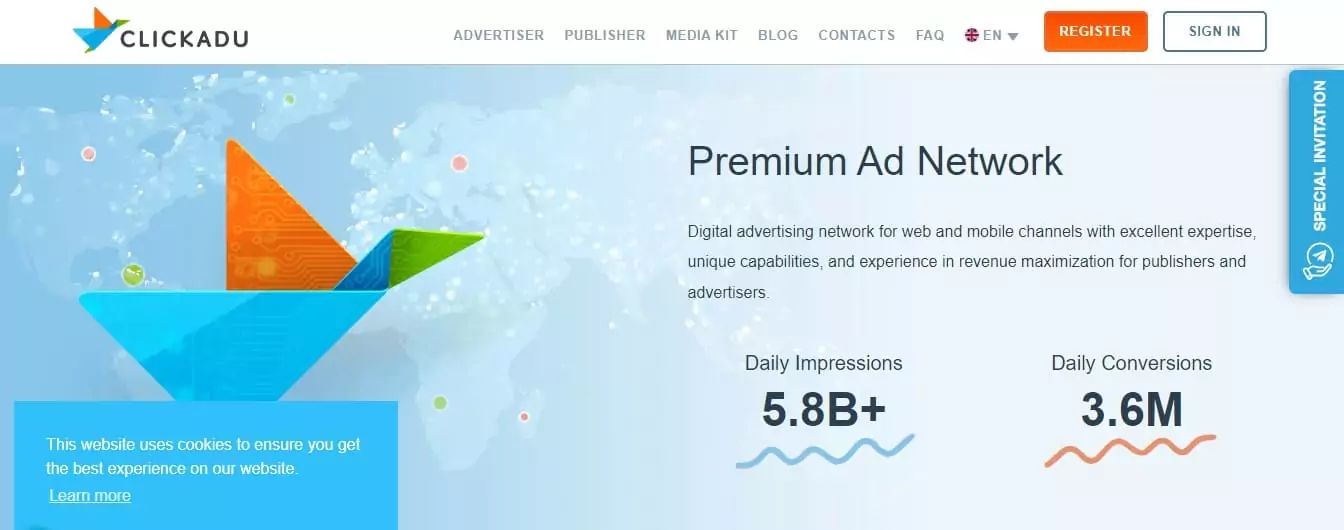
Pros
- Multiple payment methods
- Near-perfect ad fill rate
- Access to high-paying ads
Cons
- High minimum payout
Clickadu is an ad network with over 3,300 publishers registered that generate over 4 billion daily ad impressions. It’s known for its high pay and a near-perfect fill rate for different ad formats like video ads, display ads, popunders, and in-page push.
The hindrance of Clickadu for publishers is its high minimum traffic requirement.
Models: CPM, CPC, and CPA.
Minimum traffic: At least 5,000 visits daily.
Payout methods: Wire transfer, WebMoney, Paxum, and PayPal.
10. PopAds
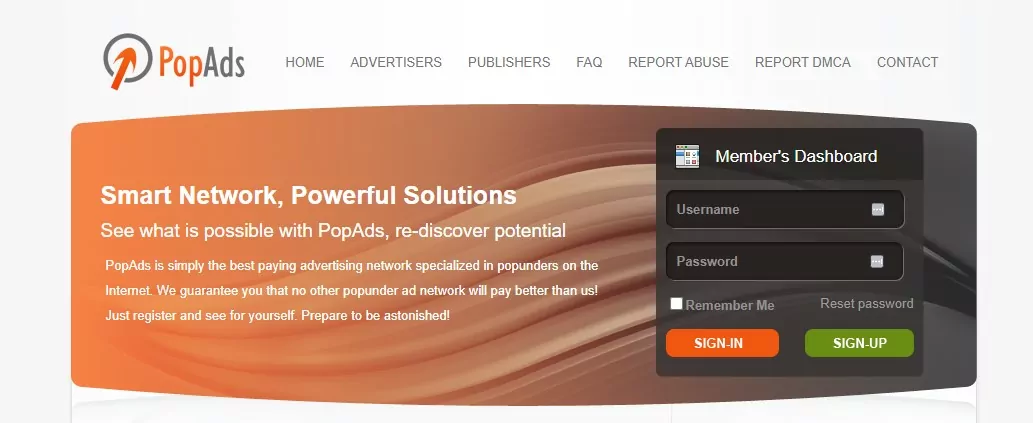
Pros
- Real-time reporting
- No minimum traffic requirements
- Access to creative popunder ads
Cons
- Limited reporting capabilities
- Supports only one ad format
PopAds is an pop under ad network specializing in Popunder ads, the type that appears beneath an active browser window. Popunders tend to pay more than other types of ad formats and are a good way to reach people that use ad-blocks. The platform has advertisers in over 40 countries and claims an average ad revenue generation of $4 for 1,000 unique U.S. visitors.
Models: Cost-per-mille (CPM).
Minimum traffic: None.
Payout methods: Payoneer, PayPal, and wire transfer.
11. ExoClick
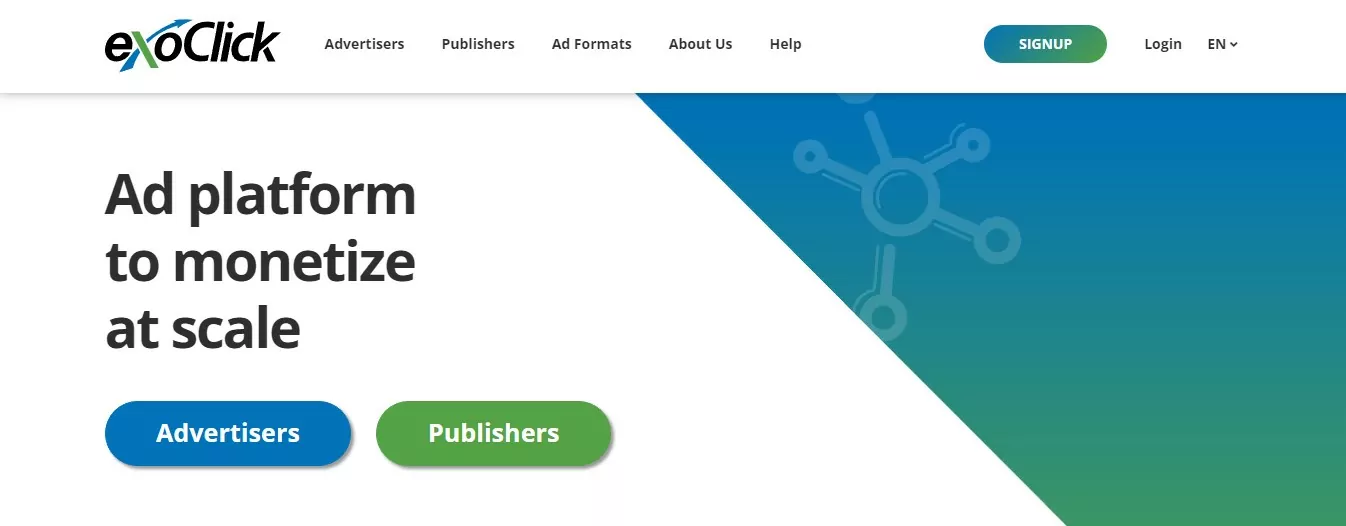
Pros
- High fill rates
- A broad range of advertisers
- Real-time bidding to help maximize your ad revenue
Cons
- High minimum payout ($50)
ExoClick is one of the leading ad networks globally. It enables publishers to monetize their traffic from every GEO and get paid either weekly or monthly. Publishers can see detailed statistics about the ads served on their site in real time and know where to adjust to maximize their ad revenue.
This network incorporates an RTB system that’s good for both publishers and advertisers. It supports various ad formats (banners, video ads, native ads, etc.) so publishers can monetize all their inventory. There’s also a tool that lets publishers circumvent ad-blocking software from their visitors and earn more ad revenue.
Models: CPM, CPC, and CPV.
Minimum traffic: None.
Payout methods: Wire transfer, Paxum, and BitPay.
12. Ezoic
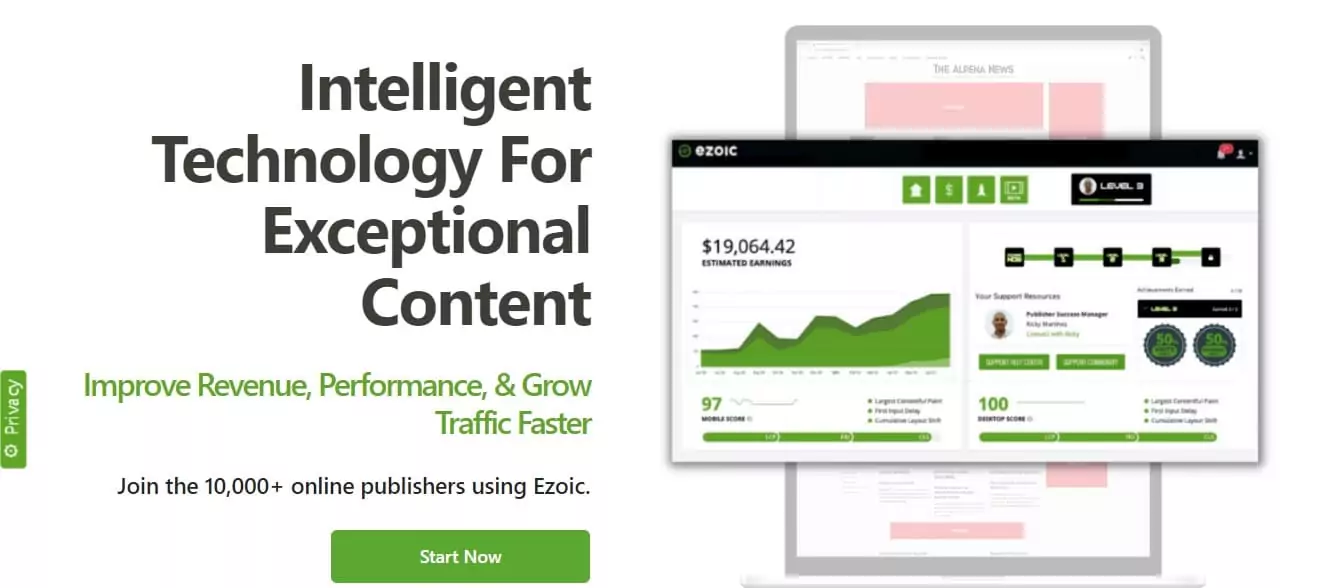
Pros
- Access to high-quality ads
- Multiple payment methods
- Complementary tools to optimize your site
Cons
- Complicated interface
- Difficult setup process
Ezoic is a popular ad-tech platform known for relatively high rates and high-quality ads. Note that Ezoic isn’t a typical ad network. Instead, it aggregates ads from different networks and offers them to publishers. The high pay occurs because of the competition from various networks for ad space on the publisher’s site.
Ezoic offers both advertisements and tools to help publishers optimize their sites for better ad revenue generation, e.g., SEO, speed booster, etc. It incorporates artificial intelligence to help decide the best position for website ad placements to earn maximum income.
This network is best suited for publishers with large traffic who want to monetize it as much as they can.
Models: CPM, CPC, and CPA.
Minimum traffic: None.
Payout methods: Direct bank transfer (Payoneer).
13. TrafficForce

Pros
- Real-time bidding
- Real-time reporting
- Customized payout schedules
Cons
- High minimum payout
TrafficForce is a premium advertising network offering high-paying ads to publishers. This network supports real-time bidding, empowering publishers to earn more revenue as advertisers compete for limited ad slots. It supports a wide range of ad formats for desktops and mobile phones, with advanced targeting that allows publishers to get the perfect ads for their audience.
A unique feature of this network is that you can choose your payout period: weekly, bi-weekly, or monthly. You also monitor real-time statistics and optimize ad performance rigorously.
Models: CPC and CPM.
Minimum traffic: None.
Payout methods: Cheque, wire transfer, Paxum, and PayPal.
14. Google Ad Exchange (AdX)
Google AdX Ad Exchange is a programmatic advertising platform that connects publishers with advertisers through real-time (RTB) bidding, programmatic auctions, which is a slightly different approach from other ad networks. It usually applies DFP (demand side platform) and AdX Services, which together are called Google Ad Manager. It allows publishers to sell inventory and ad space and advertisers bid on it based on user data.
- Publishers add AdX code to their sites. When a user visits, an auction is triggered, and the highest bidding ad is shown.
- Advertisers use a DSP to bid on inventory, targeting users by demographics, interests, or behavior.
AdX gives publishers access to premium demand-side buyers and helps advertisers reach high-quality audiences at scale within a programmatic advertising approach.
How to choose the best ad network for your site
While choosing your platform, please, mind that the right ad networks make things easier for both the publisher and the advertiser. Publishers don’t need to stress themselves pitching to advertisers when they can just sign up on an ad network and tap into its ad inventory. The advertiser doesn’t need to bother about looking for websites they can advertise on because the network takes care of that. These platforms enable many websites to survive on advertising revenue while offering their content for free.
These are the top factors to consider when choosing an ad network:
- Size — It’s wise to choose a network with a significant number of advertisers to guarantee a near-perfect ad placement rate for your app or website. A few hundred advertisers are sufficient, but the more, the better.
- Quality — Seek ad networks that follow all the security and safety requirements for your protected work process, while serving ads (for example, banner ad networks). High-quality advertisers may be big or small brands, but the main thing for them is to work responsibly. The network should have a formal vetting process for advertisers, enabling you to work with reliable and legitimate businesses.
- Advertising formats (plus advertising technology) — Go for a network that supports a large variety of ad units to give you more room to experiment and maximize your income. The same applies to advertisers to help them experiment with different formats and see which one gets the best results.
- Payment methods — Find a network with clear payment conditions, like revenue sharing model, CPM, etc., and a variety of payment options, with no risk of personal data leaks.
What’s important when choosing ad networks to monetize for publishers?

There are a few points I consider when choosing an ad network.
First, I want to make sure the network has been around for a while and has a good reputation. The ad formats they offer need to match my website’s design and generate good RPMs (revenue per thousand impressions) while not being super intrusive, to the point where it could hurt my traffic from search engines or social media.
Second, I want to make sure I understand their payment terms and methods. Having a lower payment threshold helps beginners have better cash flow, but having multiple options to get paid, such as wire transfers, Payoneer, PayPal, crypto, etc., is important for people who live in different countries.
Lastly, the more analytics the ad network gives a publisher, the better. If I can see what ad formats, users, browsers, etc., are generating more revenue, I can optimize my traffic and website to get more of that, and it’s a win-win for both the network and me.
Adsterra has accumulated the best features to help publishers increase their earnings, with over 15,000 advertisers across many niches. This is the right and secure choice for those who are looking for various user-friendly ad formats and plenty of profit opportunities and partner with one of the highest paying ad network.
Conclusion
We’ve shown you the best advertising networks you can choose in 2025. These networks empower publishers to maximize their earnings with high-quality ad units and creative formats. Each one has its unique advantages and characteristics, which we delved into.
Before choosing the best ad network, publishers should ensure that it offers creative ad formats, a high fill rate, detailed analytics, and access to high-paying ads in their niche.
You’re free to make any choice, but we’ll recommend Adsterra because of its high-quality advertisers and support for many ad units. Adsterra also provides a unique Partner Care Program to ensure a smooth onboarding process and help you across every step of your advertising journey.
Ad networks for publishers FAQ
What is the role of a publisher in an ad network?
The role of a publisher is vital in the ad network collaboration schema. Publishers provide the audience (aka traffic) for the advertising platform, which forwards the traffic to advertisers’ offers.
What are the most popular ad networks?
The most well-known ad networks are Google AdSense, Adsterra, ExoClick, Clickadu, etc. You can find out more in the article about the best CPM ad networks. These advertising platforms have good CPM rates. Google AdSense is the most popular ad network by default for most publishers. However, that doesn’t make it the best network for all publishers.
Do ad networks still exist?
Absolutely, ad networks are alive as ever. What is more, the trusted and reputable ones are able to become a reliable partner for publishers and advertisers, and their fruitful collaboration is what makes the system beneficial for every party.
How much does Adsterra pay for 1000 views in the USA per month?
The amount Adsterra pays for 1000 ad impressions in the USA per month depends on more than a single factor, like ad format, tier level, etc. Adsterra is the best-paying ad network and has no minimum traffic requirements. This encourages small publishers to join and grow their traffic and revenue over time, while medium and big publishers kick off at once with industry-advanced ad inventory and multiple ad formats.
What trends are expected in the field of advertising networks for publishers?
Affiliate marketing is the fastest-growing segment of digital advertising as a trend and closely related to the development of ad networks for publishers. It’s poised to become a bigger part of global advertising networks because of its effectiveness.
![14 Best High-Paying Ad Networks for Publishers in 2025 [Blog or Website]](https://adsterra.com/blog/wp-content/webp-express/webp-images/uploads/2023/02/ad-networks-for-publishers-2025-1-780x364.png.webp)